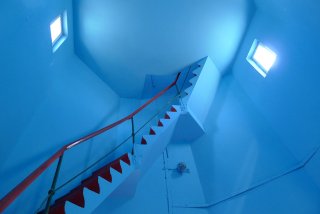
How does the label, as a "descriptive" tool that is usually essential and consensual to the integrity of an exhibition, affect the process of constructing a "cognitive experience of art and exhibition"? The relationship between the label and the work is often a two-way guidance and indication, that is to say, the label provides additional information for the work, which is dif?icult to be recognised through the work with a certain degree of probability, and through the auxiliary explanation of this information, the independence of the work can be recognised more accurately, and at the same time, it provides a directional guidance to the viewer. In this process, the physical movement of the viewer between the work and the exhibition sticker has a clear purpose, i.e., to relate to the workbybrowsingforinformation,ortobrowseforinformationbyrelatingtothework.Theexhibitionsticker,asakindof"proof"provided by the planner and initiator of the exhibition (usually the decision-maker and curator of the organisation) for the successful participation of the artist in the exhibition, makes the mutual relationship between the two parties more and more delicate in the process of the construction of the exhibition. For the construction of the exhibition itself and the logic of the concept, which party, the exhibition label or the artwork, has a more reasonable priority of existence? For those who see the sign ?irst, does the sign de?ine the properties of the space between itself and the work being described? That is, has the 'participation of the artist' been sanctioned by the core domain of exhibition power, and has the space that exists between him/her and the placed sign been de?ined by the core domain of exhibition power as a 'pathway for the validation of the description'? Conversely, does the person who sees the work ?irst have an opposing sensory experience? When their focus shifts from the "participation of the artist" to the signage that explains and guides them, can the path between the two be seen as an expression of the initiative and integrity of the "participation" itself? Is it even an assertive attitude rather than a passive state of being squeezed? How are the viewers affected by the properties of this path? After their relationship with the "artist's participation", does this path become a ?ield of ambiguity and neutrality that allows people to construct their cognitive experience of art and exhibitions with the greatest possible freedom from the concept of centrality? What happens if the different "exclusive" properties of this path are superimposed and eventually cancelled out? Does the space within this path simply retain the properties of concepts that belong both to the exhibition itself and to the space itself? What are they respectively? How do they relate to each other? And how can we construct a cognitive-experiential process of recognising art and exhibitions through such relationships?
During Haochen’s postgraduate study in MFA Fine Art at Goldsmiths, University of London, He has gradually clarified personal research direction and practice objectives. Exploring the possibility of constructing cognitive experiences through the concept of "exhibition" not only supports his practice at this stage, but also serves as a fundamental step in exploring "how art and exhibition can provide a decentred platform for critiquing and reconstructing their own concepts through the production of unique experiential processes.
haochenren77@gmail.com
IG: @renhaochen8379





